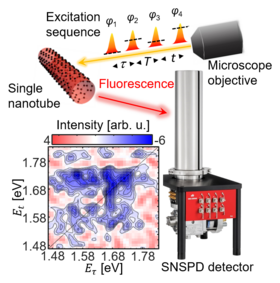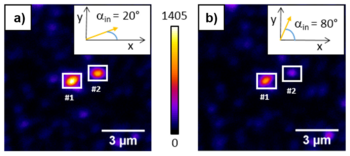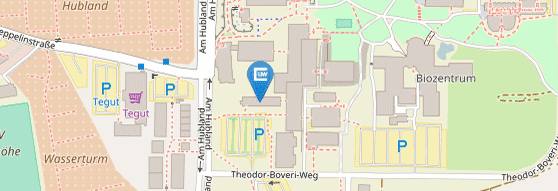Dynamics of individual quantum systems

The dynamics of single quantum systems are relevant for the further development of opto-electronic devices of reduced dimensionality (single molecule transistors) with tunable nonlinear electro-optical response. These devices can be used, for example, for optical computers. A particular research attraction is access to quantum effects at room temperature, which are masked in ensemble measurements, as well as overcoming the THz gap of signal amplification. To this end, we study, for example, single carbon nanotubes (SWCNTs) in the spectral region of the phononic sideband.
We have developed coherent two-dimensional fluorescence microspectroscopy [1-2] to image the spatiotemporal population evolution of a single quantum system, using a superconducting nanowire single-photon detector (SNSPD) for the first time (Fig. 1). In contrast to transient absorption spectroscopy, this optically high-resolution microscopy method has frequency resolution in both the pump and probe steps.
A thesis can cover many areas of work. These include the handling of lasers and optical components. In addition, depending on the topic of the thesis,
- Programming and fine adjustment of the existing setup (fiber incoupling)
- Pulse shaping and pulse compression
- Fluorescence microscopy with high spatial resolution
- Polarization-dependent measurements (excitation and fluorescence)
- Detection of single quantum systems using two-photon coincidence measurements and Mandel-Q based method
- Correlation measurements of the temporal uncertainty of the setup (jitter)
- Measurement of the lifetime and coherence time of individual quantum systems
- Interferometric measurement of excitation spectra of single quantum systems
- Two-dimensional spectroscopy on single carbon nanotubes
- Data analysis and simulations with common programs such as MatLab, Mathematica and LabVIEW
Contact:
Raphael Wichary, raphael.wichary@uni-wuerzburg.de
Literature for overview:
[1] S. Goetz et al., Opt. Express 26, 3915-3925 (2018)
[2] M. Nuß et al., “Ultrafast non-linear 2D microspectroscopy reveals coherent phonon mediated intra- and intervalley exciton interaction in an individual SWCNT”, NT19: International Conference on the Science and Application of Nanotubes and Low-Dimensional Materials, Wuerzburg, 21-26 July (2019)
Completed theses
The topic of your thesis in our working group is always assigned based on the current research work in the laboratory. Therefore, it does not make sense to constantly post new open topics here. Just contact us! In order to get an impression of possible theses in this project, a selection of already completed theses is presented below.
Bachelor thesis
Pulse shaping and polarization control with fs laser pulses in the diffraction-limited focus of a fluorescence microscope
This bachelor thesis consisted of optimizing and characterizing the new setup for measuring fluorescence-based nonlinear spectroscopy of single quantum systems, with respect to polarization control of the excitation. For complete polarization control, a fully automated series connection of two waveplates was set up. Thereupon, polarization-dependent fluorescence measurements of individual SWCNTs were used to determine their in-plane orientation (Fig. 2). In addition to the polarization direction in xy-plane, a z-component of the polarization was detected. Therefore, the results were simulated using the Jones matrix formalism and the determination of the orientation of a nanotube in space was extended using a 3D model.

Master thesis
A single-photon setup for ultrafast and highly efficient nonlinear quantum optical experiments
In this project, the existing setup was extended with the possibility of performing correlation measurements, i.e., a Hanbury-Brown-Twiss experiment. In addition to extensive programming to automate a previously planned high-efficiency single-photon setup for nonlinear quantum optical experiments with ultrafast laser pulses, the g(2) measurement was implemented for continuous wave and pulsed measurement operation. With a g(2) measurement, one can determine whether there is a single emitter in focus (e.g., a single molecule) if the g(2)(0) value is <0.5. However, for this purpose, the uncertainty of the temporal correlation measurement must be determined beforehand and the jitter of the instrument response function of the whole setup must be taken into account. Figure 3 shows the g(2) measurement on (6,4)-SWNCTs.



